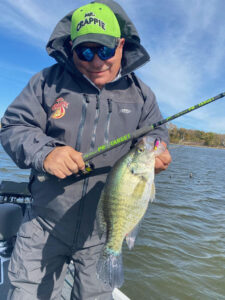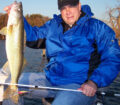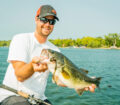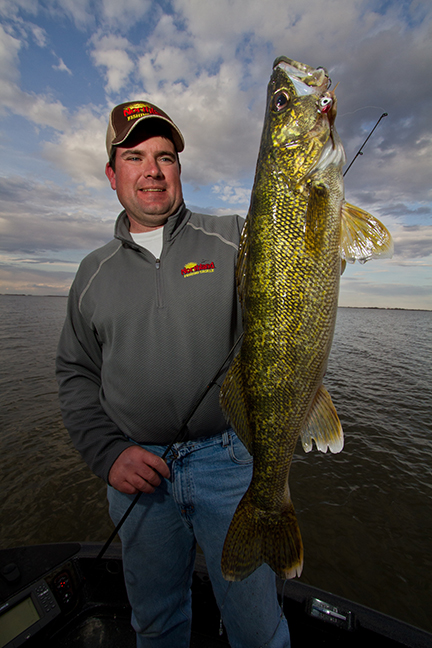By Bob Jensen
Fishing the Midwest Fishing Team

(photo by Bob Jensen) Mr. Crappie has lots of success with a jig/plastic combination in the fall.
When you go fishing, if you want to catch a fish, it’s really important that you put your bait where a fish lives. That might sound extremely basic, but the most basic concept of fishing is to fish where the fish are. You can have the shiniest boat rigged with all the newest technology, lots of expensive rods and reels and tackleboxes full of lures, but if you don’t put your lure near a fish, all that other stuff is going to do you no good. Here are some ideas for finding different species of fish in the fall months throughout the Midwest.
Let’s start with crappies. Crappies are abundant and popular almost everywhere. In the spring we catch them near cover like rushes, docks, and timber in shallow water. In the fall, for the most part, if you fish those areas you won’t be eating any crappies for supper. They’re just not in the shallows in large numbers in the fall.
In some lakes the crappies will be on or near the deep weedline. The clearer the water, the deeper they’ll be. Sometimes they’ll be a cast away from the edge of the deep weedline. On a calm evening you can see them creating dimples as they suck bugs off the surface of the water. Cast a Mr. Crappie Grub on a sixteenth ounce jig to the area where the dimples are. Crappies and bluegills will eat it up.
Crappies will also be found near the bottom in the basin of some lakes. Cruise the basin in 25-30 feet of water with a close eye on your sonar. When you see a concentration of fish, drop an eighth or sixteenth ounce jig tipped with a Mr. Crappie Lightning Shad. You’ll catch perch along with the crappies.
Walleyes can be in a lot of places depending on the lake. Different lakes provide different hang-outs. In shallow lakes, you can find walleyes on windblown points close to shore. In deep, clear lakes they’ll be in 20 feet of water or more on structure like rock piles or points. They’ll suspend away from structure near baitfish in some bodies of water, and they’ll go on a night-bite in some lakes. Research the lake you’ll be fishing to determine where you should focus your efforts.
Largemouth bass will also be in different areas, but as the weather gets colder, you’ll find fewer of them in the sloppy shallows that many inhabited during the summer. However, on a warm day in the fall, especially at mid-day, you can find them cruising reed beds near deeper water. Reed beds in six to eight feet of water that are close to cabbage beds in 12-15 feet of water can be very good.
The bass hold in the deeper water during cold conditions, then move shallower when there’s a day or two of warmer weather. A spinnerbait used to be the go-to bait for largemouth in the reeds, and they’ll still catch bass, but swimming jigs are taking as many and maybe more bass in today’s world. Attach a Rage Craw in a contrasting color to the jig.
Be aware that some lakes have a lot more options than others for fall fish. In some lakes there will be just a couple types of structure that will hold fish, on other lakes you’ll need to try different things to get bit. Keep that in mind and you’ll find yourself getting lots of bites.

















